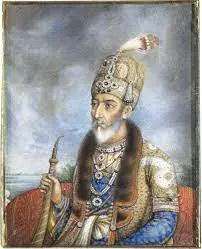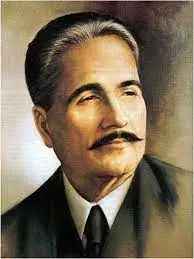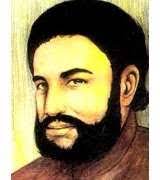Abu Zafar Sirajuddin Muhammad Bahadur Shah ‘Zafar’, also known as ‘Bahadur Shah’ or ‘Bahadur Shah II’ was the last of the Mughal emperors in India, as well as the last ruler of the Taimuri Dynasty. He was born on 24th, October 1775. He was the son of Akbar Shah II and Lalbai, a Hindu Rajput. He became the Mughal Emperor upon his father's death on 28 September 1837. As an Urdu poet he adopted ‘Zafar’ as his ‘takhallus’ and was popularly also known as Bahadur Shah Zafar.
Zafar's father, Akbar Shah II, ruled over a rapidly disintegrating empire. It was during the last three decades of the eighteenth century that the Mughal emperor eventually ceased to have any real power. The defeat of the combined forces of Emperor Shah Alam (1759-1806) and the Nawab of Awadh by the Company at Baksar in 1764, and the blinding of the emperor in 1788 by the Rohilla chieftain Ghulam Qadir, were two events that did much to shatter the prestige of the Mughals. It was during the time of Akbar Shah that the East India Company dispensed with the illusion of Mughal ruling and removed his name from the coins in the areas under their control. Bahadur Shah, after the death of his father, was placed on the throne in 1837 when he was little over 60 years of age.
As Emperor
Bahadur Shah Zafar, came to throne when the Mughal rule was nearing its end. The British had curtailed the power and privileges of the Mughal rulers to such an extent that by the time of Bahadur Shah Zafar, the Mughal rule was confined to the Red Fort. Bahadur Shah Zafar was obliged to live on British pension, while the reins of real power lay in the hands of the East India Company. He himself did not take an interest in statecraft or possess any imperial ambitions.
During the reign of Bahadur Shah Zafar, Urdu poetry flourished and reached its zenith. He himself was a prolific poet and an accomplished calligrapher. He had acquired his poetic taste from his grandfather and father who were also poets. He passed most of his time in the company of poets and writers and was the author of four diwans. He wrote a large number of Urdu ghazals. While some part of his opus was lost or destroyed during the Indian Rebellion of 1857-1858, a large collection did survive, and was later compiled into the Kulliyyat-e-Zafar. Most of his poetry is full of pain and sorrow owing to the distress and degradation he had to face at the hands of the British. He was a great patron of poetry and literary work and some of the most eminent and famous Urdu poets like Mirza Ghalib, Zauq, Momin and Daagh were of his time.
Events of 1857
It was at the time of Bahadur Shah that the War of Independence in 1857 started. Sepoy regiments seized Delhi. Seeking a figure that could unite all Indians, Hindu and Muslim alike, most rebelling Indian kings and the freedom fighters found the symbol of freedom in Bahadur Shah and therefore nominated him as emperor of whole of India and their Commander-in-Chief. In the initial stages, the freedom fighters were successful, but later on the strong and organized British forces defeated them and Bahadur Shah, was overthrown.
When the victory of the British became certain, Zafar took refuge at Humayun's Tomb, in an area that was then at the outskirts of Delhi, and hid there. British forces led by Major William Hodson surrounded the tomb and compelled his surrender on 20 September 1857. The next day Hodson shot his sons ‘Mirza Mughal’, ‘Mirza Khizr Sultan’, and grandson ‘Mirza Abu Bakr’ under his own authority at the Khooni Darwaza (the bloody gate) near Delhi Gate. Numerous male members of his family were killed by British forces and imprisoned or exiled the surviving members of the Mughal dynasty.
After the recapture of Delhi in mid-September 1857, the British carried out a mock trial of Bahadur Shah. This sham show was conducted by a military commission. It lasted from 27 January to 9 March 1858. At the end of the trial Bahadur Shah was convicted of treason and of having abetted the killing of Europeans. Neither of these charges had any legal substance. In October 1858 Bahadur Shah, was exiled to Rangoon, Burma (now Yangon, Myanmar) along with his wife ‘Zeenat Mahal’ and some of the remaining members of the family. His departure as Emperor marked the end of more than three centuries of Mughal rule in India.
Bahadur Shah died in exile on 7 November 1862. He was buried near the Shwedagon Pagoda in Yangon, at the site that later became known as Bahadur Shah Zafar Dargah. His wife Zeenat Mahal died in 1886.
As a Poet
He had initially been a ‘Shagird’ of ‘Shah Nasir’ who had nurtured several up-and-coming poets during the 1830s. When Shah Nasir left Delhi around 1840, Zafar became a pupil of ‘Zauq’, and after Zauq’s death in 1854 he acknowledged ‘Ghalib’ as his ustad. Many of the literary figures who were part of the circle with which Zafar interacted were also associated with the vibrant intellectual life of Delhi College, ‘Aazurda’ and ‘Sahbai’ for example. The fact that Bahadur Shah was so intimately associated with such a rich literary and intellectual tradition, added to his stature particularly among the north Indian intelligentsia. Urdu-Hindustani was the common language of this intelligentsia. Bahadur Shah enjoyed a prestige that went beyond his political position.
Zafar’s poetry is built around his personal experience of loss, defeat and despair. His famous couplet ‘Lagta Nahin Hai Ji Mera Ujre Dayaar Mein’ sums up the one important theme of his poetry; the theme of the callousness of life and time, of the inconstancy of friends, and of the helplessness of man. Zafar's poetry tells the tale of a king who has been ruthlessly deprived of his power and position, whose sons and relations were done to death before his eyes, and who was forced to live in exile far from his beloved land. Among the other important themes of Zafar's poetry may be mentioned his impressive handling of didactic and ethical subjects, and his sensitive concern for the universal process of change and decay constantly operative in the world. According to ‘Mohammed Hussain Azad’, the author of ‘Aab-e-Hayaat’, many of these poems were actually written by ‘Zauq’, who generously passed them on to his royal disciple, Zafar. Some of the modern critics, however, dispute this view. They feel that Azad's assertion is based more on his personal regard for his poetic mentor, Zauq, than on actual fact. Zafar was a poet of no mean merit. He could legitimately get his verse corrected from Zauq, but he would not attribute to himself what was actually written by others. It will be unfair, therefore, to call him a plagiarist
Religious attitudes
Bahadur Shah Zafar was a devout Sufi. Zafar was himself regarded as a Sufi Peer and used to accept mureeds or pupils. Prior to his accession, in his youth he made it a point to live and look like a poor scholar and darvesh, in stark contrast to his three brothers, Mirza Jahangir, Salim and Babur.
As a poet and darvesh, Zafar imbibed the highest subtleties of mystical Sufi teachings. At the same time, he was deeply susceptible to the magical and superstitious side of Orthodox Sufism. Like many of his followers, he believed that his position as both a Sufi Peer and emperor gave him tangible spiritual powers. The emperor also had a staunch belief in Taaveez or charms. A coterie of peers, miracle workers and Hindu astrologers were in constant attendance to the emperor. On their advice, he also regularly donated cows to the poor, elephants to the sufi shrines and a horse to the khadims or clergy of Jama Masjid.
Zafar consciously saw his role as a protector of his Hindu subjects, and a moderator of the intense puritanism of many of the Orthodox Muslim Ulema. In one of his verses, Zafar explicitly stated that both Hinduism and Islam shared the same essence. This syncretic philosophy was implemented by his court which came to cherish and embody a multicultural composite Hindu-Islamic Mughal culture. For instance, the Hindu elite used to frequently visit the dargah or tomb of the great Sufi Peer, ‘Nizam-ud-din Auliya’. They could quote ‘Hafiz’ and were very fond of Persian poetry. Their children, especially those belonging to the administrative ‘Khatri’ and ‘Kayasth’ castes studied under Maulvis and attended the more liberal madarsas. On the other hand, the emperor's Muslim subjects emulated him in honouring the Hindu holy men, while many in court, including Zafar himself, followed the old Mughal custom, originally borrowed from high class Hindus, of only drinking the water from the Ganges.
Zafar and his court used to celebrate Hindu festivals. During the spring festival of Holi, he would spray his courtiers, wives and concubines with different coloured paints, initiating the celebrations by bathing in the water of seven wells. The autumn Hindu festival of Dusshera was celebrated in the palace by the distribution of nazrs or presents to Zafar's Hindu officers. In the evening, Zafar would then watch the ‘Ram Lila’ processions annually celebrated in Delhi with the burning of giant effigies of Ravana and his brothers. He even went to the extent of demanding that the route of the procession be changed so that it would skirt the entire flank of the palace, allowing it to be enjoyed in all its glory. On Diwali, Zafar would weigh himself against seven kinds of grain, gold, coral, etc., and directed their distribution among the city's poor.
Zafar Mahal
Zafar Mahal was originally built by Akbar II, but it was his son, Bahadur Shah Zafar, who constructed the gateway and added to the palace in the mid-19th century. Mehrauli was then a popular venue for hunting parties, picnics and jaunts, and the dargah was an added attraction. The emperor visited often with his retinue - and stayed in royal style at Zafar Mahal. The ‘Phool Walon Ki Sair’ gradually turned into a major three day celebration during the time of Bahadur Shah Zafar. Zafar used to move his court to a building adjacent to the Shrine of ‘Khwaja Bakhtiyar Kaki’ and stayed at Mehrauli for a week during the celebrations. The building where he stayed during the period was originally built by his father and Zafar added an impressive gate and a Baaradari to the structure and renamed it Zafar Mahal. The celebrations spread out in different parts of Mehrauli with the ‘Jahaz Mahal’, becoming a center where Qawwali mehfils would be organised while the ‘Jharna’, built by ‘Firoz Shah Tughlaq’ and later added to by ‘Akbar Shah II’ became a place where the women of the court relaxed.
Legacy
In 1959, the All India Bahadur Shah Zafar Academy was founded expressly to spread awareness of his contribution to the first major anti-British movement in India. Several movies in Hindi or Urdu have depicted his role during the rebellion of 1857. Roads bearing his name are found in New Delhi, Lahore, Varanasi, and other cities. A statue of Bahadur Shah Zafar has been erected at the Vijayanagaram palace in Varanasi. In Bangladesh, the Victoria Park in old Dhaka has been renamed "Bahadur Shah Zafar Park". And in several Pakistani cities, avenues, roads, shopping centres, and other landmarks carry the name of the last Mughal emperor.
Abu Zafar Sirajuddin Muhammad Bahadur Shah ‘Zafar’, also known as ‘Bahadur Shah’ or ‘Bahadur Shah II’ was the last of the Mughal emperors in India, as well as the last ruler of the Taimuri Dynasty. He was born on 24th, October 1775. He was the son of Akbar Shah II and Lalbai, a Hindu Rajput. He became the Mughal Emperor upon his father's death on 28 September 1837. As an Urdu poet he adopted ‘Zafar’ as his ‘takhallus’ and was popularly also known as Bahadur Shah Zafar.@@Zafar's father, Akbar Shah II, ruled over a rapidly disintegrating empire. It was during the last three decades of the eighteenth century that the Mughal emperor eventually ceased to have any real power. The defeat of the combined forces of Emperor Shah Alam (1759-1806) and the Nawab of Awadh by the Company at Baksar in 1764, and the blinding of the emperor in 1788 by the Rohilla chieftain Ghulam Qadir, were two events that did much to shatter the prestige of the Mughals. It was during the time of Akbar Shah that the East India Company dispensed with the illusion of Mughal ruling and removed his name from the coins in the areas under their control. Bahadur Shah, after the death of his father, was placed on the throne in 1837 when he was little over 60 years of age.@@As Emperor@@Bahadur Shah Zafar, came to throne when the Mughal rule was nearing its end. The British had curtailed the power and privileges of the Mughal rulers to such an extent that by the time of Bahadur Shah Zafar, the Mughal rule was confined to the Red Fort. Bahadur Shah Zafar was obliged to live on British pension, while the reins of real power lay in the hands of the East India Company. He himself did not take an interest in statecraft or possess any imperial ambitions.@@During the reign of Bahadur Shah Zafar, Urdu poetry flourished and reached its zenith. He himself was a prolific poet and an accomplished calligrapher. He had acquired his poetic taste from his grandfather and father who were also poets. He passed most of his time in the company of poets and writers and was the author of four diwans. He wrote a large number of Urdu ghazals. While some part of his opus was lost or destroyed during the Indian Rebellion of 1857-1858, a large collection did survive, and was later compiled into the Kulliyyat-e-Zafar. Most of his poetry is full of pain and sorrow owing to the distress and degradation he had to face at the hands of the British. He was a great patron of poetry and literary work and some of the most eminent and famous Urdu poets like Mirza Ghalib, Zauq, Momin and Daagh were of his time.@@Events of 1857@@It was at the time of Bahadur Shah that the War of Independence in 1857 started. Sepoy regiments seized Delhi. Seeking a figure that could unite all Indians, Hindu and Muslim alike, most rebelling Indian kings and the freedom fighters found the symbol of freedom in Bahadur Shah and therefore nominated him as emperor of whole of India and their Commander-in-Chief. In the initial stages, the freedom fighters were successful, but later on the strong and organized British forces defeated them and Bahadur Shah, was overthrown.@@When the victory of the British became certain, Zafar took refuge at Humayun's Tomb, in an area that was then at the outskirts of Delhi, and hid there. British forces led by Major William Hodson surrounded the tomb and compelled his surrender on 20 September 1857. The next day Hodson shot his sons ‘Mirza Mughal’, ‘Mirza Khizr Sultan’, and grandson ‘Mirza Abu Bakr’ under his own authority at the Khooni Darwaza (the bloody gate) near Delhi Gate. Numerous male members of his family were killed by British forces and imprisoned or exiled the surviving members of the Mughal dynasty.@@After the recapture of Delhi in mid-September 1857, the British carried out a mock trial of Bahadur Shah. This sham show was conducted by a military commission. It lasted from 27 January to 9 March 1858. At the end of the trial Bahadur Shah was convicted of treason and of having abetted the killing of Europeans. Neither of these charges had any legal substance. In October 1858 Bahadur Shah, was exiled to Rangoon, Burma (now Yangon, Myanmar) along with his wife ‘Zeenat Mahal’ and some of the remaining members of the family. His departure as Emperor marked the end of more than three centuries of Mughal rule in India.@@Bahadur Shah died in exile on 7 November 1862. He was buried near the Shwedagon Pagoda in Yangon, at the site that later became known as Bahadur Shah Zafar Dargah. His wife Zeenat Mahal died in 1886.@@As a Poet@@He had initially been a ‘Shagird’ of ‘Shah Nasir’ who had nurtured several up-and-coming poets during the 1830s. When Shah Nasir left Delhi around 1840, Zafar became a pupil of ‘Zauq’, and after Zauq’s death in 1854 he acknowledged ‘Ghalib’ as his ustad. Many of the literary figures who were part of the circle with which Zafar interacted were also associated with the vibrant intellectual life of Delhi College, ‘Aazurda’ and ‘Sahbai’ for example. The fact that Bahadur Shah was so intimately associated with such a rich literary and intellectual tradition, added to his stature particularly among the north Indian intelligentsia. Urdu-Hindustani was the common language of this intelligentsia. Bahadur Shah enjoyed a prestige that went beyond his political position.@@Zafar’s poetry is built around his personal experience of loss, defeat and despair. His famous couplet ‘Lagta Nahin Hai Ji Mera Ujre Dayaar Mein’ sums up the one important theme of his poetry; the theme of the callousness of life and time, of the inconstancy of friends, and of the helplessness of man. Zafar's poetry tells the tale of a king who has been ruthlessly deprived of his power and position, whose sons and relations were done to death before his eyes, and who was forced to live in exile far from his beloved land. Among the other important themes of Zafar's poetry may be mentioned his impressive handling of didactic and ethical subjects, and his sensitive concern for the universal process of change and decay constantly operative in the world. According to ‘Mohammed Hussain Azad’, the author of ‘Aab-e-Hayaat’, many of these poems were actually written by ‘Zauq’, who generously passed them on to his royal disciple, Zafar. Some of the modern critics, however, dispute this view. They feel that Azad's assertion is based more on his personal regard for his poetic mentor, Zauq, than on actual fact. Zafar was a poet of no mean merit. He could legitimately get his verse corrected from Zauq, but he would not attribute to himself what was actually written by others. It will be unfair, therefore, to call him a plagiarist@@Religious attitudes@@Bahadur Shah Zafar was a devout Sufi. Zafar was himself regarded as a Sufi Peer and used to accept mureeds or pupils. Prior to his accession, in his youth he made it a point to live and look like a poor scholar and darvesh, in stark contrast to his three brothers, Mirza Jahangir, Salim and Babur.@@As a poet and darvesh, Zafar imbibed the highest subtleties of mystical Sufi teachings. At the same time, he was deeply susceptible to the magical and superstitious side of Orthodox Sufism. Like many of his followers, he believed that his position as both a Sufi Peer and emperor gave him tangible spiritual powers. The emperor also had a staunch belief in Taaveez or charms. A coterie of peers, miracle workers and Hindu astrologers were in constant attendance to the emperor. On their advice, he also regularly donated cows to the poor, elephants to the sufi shrines and a horse to the khadims or clergy of Jama Masjid.@@Zafar consciously saw his role as a protector of his Hindu subjects, and a moderator of the intense puritanism of many of the Orthodox Muslim Ulema. In one of his verses, Zafar explicitly stated that both Hinduism and Islam shared the same essence. This syncretic philosophy was implemented by his court which came to cherish and embody a multicultural composite Hindu-Islamic Mughal culture. For instance, the Hindu elite used to frequently visit the dargah or tomb of the great Sufi Peer, ‘Nizam-ud-din Auliya’. They could quote ‘Hafiz’ and were very fond of Persian poetry. Their children, especially those belonging to the administrative ‘Khatri’ and ‘Kayasth’ castes studied under Maulvis and attended the more liberal madarsas. On the other hand, the emperor's Muslim subjects emulated him in honouring the Hindu holy men, while many in court, including Zafar himself, followed the old Mughal custom, originally borrowed from high class Hindus, of only drinking the water from the Ganges.@@Zafar and his court used to celebrate Hindu festivals. During the spring festival of Holi, he would spray his courtiers, wives and concubines with different coloured paints, initiating the celebrations by bathing in the water of seven wells. The autumn Hindu festival of Dusshera was celebrated in the palace by the distribution of nazrs or presents to Zafar's Hindu officers. In the evening, Zafar would then watch the ‘Ram Lila’ processions annually celebrated in Delhi with the burning of giant effigies of Ravana and his brothers. He even went to the extent of demanding that the route of the procession be changed so that it would skirt the entire flank of the palace, allowing it to be enjoyed in all its glory. On Diwali, Zafar would weigh himself against seven kinds of grain, gold, coral, etc., and directed their distribution among the city's poor.@@Zafar Mahal@@Zafar Mahal was originally built by Akbar II, but it was his son, Bahadur Shah Zafar, who constructed the gateway and added to the palace in the mid-19th century. Mehrauli was then a popular venue for hunting parties, picnics and jaunts, and the dargah was an added attraction. The emperor visited often with his retinue - and stayed in royal style at Zafar Mahal. The ‘Phool Walon Ki Sair’ gradually turned into a major three day celebration during the time of Bahadur Shah Zafar. Zafar used to move his court to a building adjacent to the Shrine of ‘Khwaja Bakhtiyar Kaki’ and stayed at Mehrauli for a week during the celebrations. The building where he stayed during the period was originally built by his father and Zafar added an impressive gate and a Baaradari to the structure and renamed it Zafar Mahal. The celebrations spread out in different parts of Mehrauli with the ‘Jahaz Mahal’, becoming a center where Qawwali mehfils would be organised while the ‘Jharna’, built by ‘Firoz Shah Tughlaq’ and later added to by ‘Akbar Shah II’ became a place where the women of the court relaxed.@@Legacy@@In 1959, the All India Bahadur Shah Zafar Academy was founded expressly to spread awareness of his contribution to the first major anti-British movement in India. Several movies in Hindi or Urdu have depicted his role during the rebellion of 1857. Roads bearing his name are found in New Delhi, Lahore, Varanasi, and other cities. A statue of Bahadur Shah Zafar has been erected at the Vijayanagaram palace in Varanasi. In Bangladesh, the Victoria Park in old Dhaka has been renamed "Bahadur Shah Zafar Park". And in several Pakistani cities, avenues, roads, shopping centres, and other landmarks carry the name of the last Mughal emperor.@@



